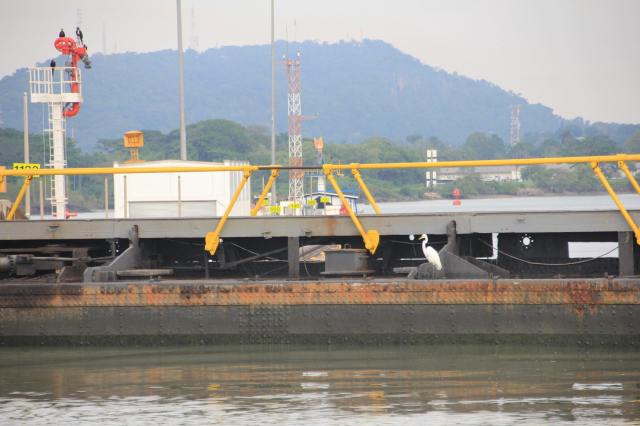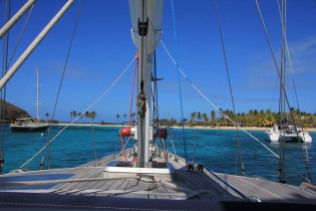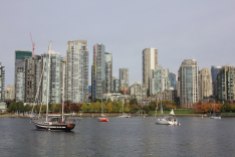It was a very early start on Sunday morning, up at 2am sharp to prepare to leave Shelter Bay Marina having collected our two new crew members, Karolin and Patrick, the night before and enjoying our last evening meal in the Caribbean at the marina. With 8 tyres wrapped in plastic as additional fenders and four 125 metre lines on board for the locks, we all huddled in the shelter of the cockpit as the heavens opened on cue and torrential tropical rain bounced off the deck. We had to be at ‘The Flats’ anchorage at the entrance of Gatun locks by 4am to receive on board our Advisor for the transit. We arrived in good time (which is unusual for us!) and shortly after dropping the anchor a pilot boat came alongside to deliver our adviser for the day. The poor guy almost got thrown in the deep as the pilot boat slammed in reverse for no apparent reason just as he was about to jump. A second attempt was more successful and we welcomed Roy on board. All yachts transiting the canal have to have an advisor on board, he directs the skipper through the whole transit and we felt so lucky to have been allocated Roy as he was not only a very knowledgable guy who filled us with confidence but great fun and a real pleasure to have on board.

Lines and tyres delivered ready for the locks

Geoff preparing the lines in the midday sun
There were two other yachts waiting in The Flats so our transit would be nested, three boats rafted together going through the locks ‘as one’, but an argument between advisors began over who should be the centre boat. One of the other boats wanted to be centre, quite a stupid thought as the centre boat controls all three, we were three times heavier than the other boat and a bit longer. Roy pulled rank and won the day and the most sensible option was confirmed, we would be centre of the nest but would take a bow line to the lock instead of the little yellow boat to our port side as their cleats would have struggled to hold us. As light filled the sky the rain stopped and we motored to the entrance of the canal behind the large tanker that would also share our lock, and rafted up with the other two boats. Roy directed all three, giving instructions to all skippers as to turning the wheel and speed etc and we entered the lock with no problems at all.


Once inside the locks thin lines with ‘monkey fist’ knots on the end are accurately thrown down to the two outer boats from the lock walls, these are attached to long lines on the bow and stern of the outer boats usually and fed back up to the bollards on the walls, we had just one of these lines on our port bow so the locks would be easy for us with just one line to control instead of four. As the gates shut behind us I said a final goodbye to the Caribbean and watched the water swirling around beneath us as the locks flooded, we were to go up a ladder of three locks in this way all nested together until we entered the Gatun Lake at the top where we separated and made our way across the lake.

Our bow line gets taken up to the top of the lock wall with the little yellow boat tied to our port side



Goodbye Caribbean!

Gatun Lock gates shut behind us

Water swirling in the lock as its flooded

Top Crew – Patrick and Karolin handle the lock line as we reach the top

Onward into lock 2 of 3 at Gatun

Another large ship enters the first chamber behind us

The large ships have their lines controlled by electric locomotives which run along the lock walls
Each lock chamber is 110 x 1000 feet and were built in pairs to handle two-way traffic. Construction started in 1909 and took four years to build, with no pumps to move water just gravity alone, all three Gatun chambers raise the boat a total of 85 feet into Gatun Lake.
Water is admitted or released through giant tunnels, or culverts, eighteen feet in diameter, running lengthwise within the center and side walls of the locks. Branching off at right angles to these culverts, smaller culverts run laterally under the floor of each lock chamber, 20 to each chamber. Each cross culvert has five openings for a total of 100 holes in each chamber for the water to enter or drain, depending on which valves are opened or closed. This large number of holes distributes the water evenly over the full floor area to control turbulence.
To fill a lock, the main valves at the lower end of the chamber are closed, while those at the upper end are opened. The water pours from the lake through the large culverts into the cross culverts and up through the holes in the chamber floor. The water movement also generates power to operate the electric motors that open and close the lock gates which swing like double doors.

Entering Gatun Lake we got ready to untie from the other boats











Catching a lift on the anchor

Another hitch-hiker
It took a few hours to motor across the lake and follow the channel towards the Pedro Miguel lock. We were scheduled to enter the next lock at 14.40 so we had an hour to kill which gave us time to attach to a buoy at the entrance to Gaillard Cut, an excavated gorge 8 miles long, and have lunch together.
After a morning of glorious sunshine the dark clouds rolled in and the Panamanian rain started again just as we approached the next lock. Pedro Miguel is a single lock going down into another lake and then a mile further we reached the final set of two locks, the Miraflores. I had been in contact with my Mum via WhatsApp all morning as she tracked our progress, and she watched us in both the Gatun and Miraflores locks on the Canals webcams. It was so nice to know she was watching us!


What a team! Our last set of locks before the Pacific

Our two very special volunteer helpers, Karolin and Patrick from Germany, helped make our transit a very smooth one even in the pouring rain, and were great fun to be with.


An egret uses the lock gate as a fishing hot spot

The locomotive track along the lock wall


The gates open into our last lock before the Pacific as Karolin handles our bow line




This is it, hello Pacific Ocean!


The Bridge of the Americas spans the entrance to the canal on the Pacific side

Panama City
Moving from the first Miraflores lock to the second still nested with the other boats, the strong currents caused by seawater mixing with fresh can play havoc with boats, we had heard stories of yachts being turned 180 degrees by it and some have even hit the lock walls. Roy had pre-warned all three skippers and instructed each boat in how to manouevre to get through it without damage, and he executed the plan perfectly. It was wonderful to share the whole experience with Geoff and Jane whose invaluable help with preparing not only Joy but also the food and drinks to keep the crew happy during the long transit was greatly appreciated.
The whole day had gone like clockwork with a great team on board Joy making our day a very special and memorable one.
































Pingback: Meer geht gerade (noch) nicht… – Weltwärts